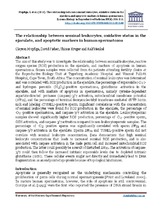| dc.contributor.author | Mupfiga, Cleyson | |
| dc.contributor.author | Fisher, David | |
| dc.contributor.author | Kruger, Thinus | |
| dc.contributor.author | Henkel, Ralf | |
| dc.date.accessioned | 2018-02-27T13:48:59Z | |
| dc.date.available | 2018-02-27T13:48:59Z | |
| dc.date.issued | 2013 | |
| dc.identifier.citation | Mupfiga, C. et al. (2013). The relationship between seminal leukocytes, oxidative status in the ejaculate, and apoptotic markers in human spermatozoa. Systems Biology in Reproductive Medicine, 59(6): 304-311. | en_US |
| dc.identifier.issn | 1939-6368 | |
| dc.identifier.uri | http://dx.doi.org/10.3109/19396368.2013.821540 | |
| dc.identifier.uri | http://hdl.handle.net/10566/3544 | |
| dc.description.abstract | The aim of this study was to investigate the relationship between seminal leukocytes, reactive oxygen species (ROS) production in the ejaculate, and markers of apoptosis in human spermatozoa. Semen samples were collected from 60 patients attending fertility clinics at the Reproductive Biology Unit at Tygerberg Academic Hospital and Vincent Pallotti Hospital, Cape Town, South Africa. The concentration of seminal leukocytes was determined and was correlated with ROS production in the ejaculate, the percentage of superoxide (·O2 )- and hydrogen peroxide (H2O2)-positive spermatozoa, glutathione activation in the ejaculate, and with markers of apoptosis in spermatozoa, namely cysteine-dependent aspartate-directed proteases (caspase)-3/7 activation, mitochondrial membrane potential (ΔΨm), and the percentage of terminal deoxynucleotidyl transferase-mediated dUTP-biotin nick end labeling (TUNEL)-positive sperm. Significant correlations with the concentration of seminal leukocytes were found for ROS production in the ejaculate, the percentage of ·O2 -positive spermatozoa, and caspase-3/7 activation in the ejaculate. Leukocytospermic samples showed significantly higher ROS production, percentage of ·O2 -positive sperm, GSH activation, and caspase-3/7 activation compared to non-leukocytospermic samples. The percentage of ·O2 -positive sperm was significantly correlated with sperm ΔΨm and caspase-3/7 activation in the ejaculate. Sperm ΔΨm and TUNEL-positive sperm did not correlate with seminal leukocyte concentration. Data demonstrate that high seminal leukocyte concentrations that leads to increased seminal ROS production, and is also associated with caspase activation in the male germ cell and increased mitochondrial ROS production. The latter could possibly be a result of disturbed ΔΨm. The activation of caspase-3/7 could then follow the increased intrinsic superoxide levels due to depleted intrinsic glutathione (GSH). These cellular events might not directly and immediately lead to DNA fragmentation as an endpoint of apoptosis because of topological hindrances. | en_US |
| dc.language.iso | en | en_US |
| dc.publisher | Taylor & Francis | en_US |
| dc.rights | This is the author-version of the article published online at: http://dx.doi.org/10.3109/19396368.2013.821540 | |
| dc.subject | Apoptosis | en_US |
| dc.subject | Human spermatozoa | en_US |
| dc.subject | Leukocytes | en_US |
| dc.subject | ROS production | en_US |
| dc.title | The relationship between seminal leukocytes, oxidative status in the ejaculate, and apoptotic markers in human spermatozoa | en_US |
| dc.type | Article | en_US |
| dc.privacy.showsubmitter | FALSE | |
| dc.status.ispeerreviewed | TRUE | |
| dc.description.accreditation | Web of Science | |

